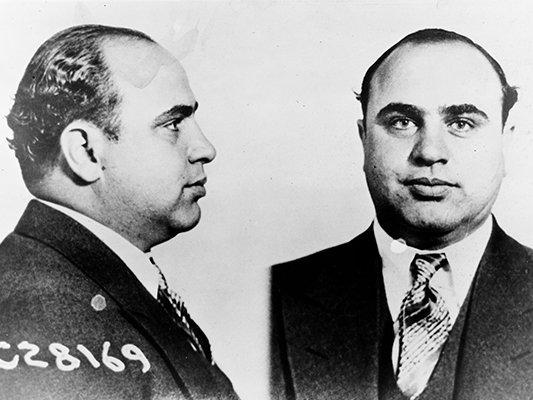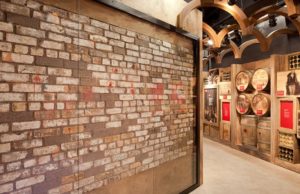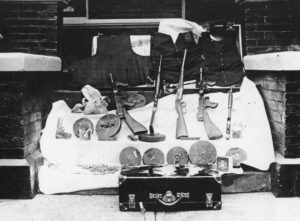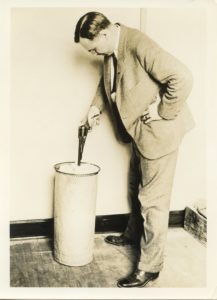Al Capone and the romantic holiday that triggered his demise
Mob Museum’s seventh anniversary coincides with 90th anniversary of St. Valentine’s Day Massacre

Ninety years ago this week, one of the most horrifying acts of violence in organized crime history occurred inside a nondescript garage at 2122 North Clark Street in Chicago. On the morning of February 14, 1929, seven members of George “Bugs” Moran’s North Side bootlegging gang were lined up against a brick wall and shot dead. The perpetrators were never prosecuted, but few people then or now doubt that Al Capone’s Outfit was behind what the press called the St. Valentine’s Day Massacre. There had been a whole lot of shooting between Chicago’s rival Irish and Italian bootleggers during Prohibition, and the Massacre was the extreme culmination of those gun battles.

Seven years ago this week, The Mob Museum opened its doors in downtown Las Vegas. The Museum’s premier artifact was a large collection of bricks from the wall against which those North Side gangsters were shot. Upon learning that the North Clark Street garage was going to be torn down in 1967, an entrepreneur named George Patey recognized the historical value of those bricks. He acquired them and wrote letters and numbers on each brick so that part of the wall could be re-created accurately in another location. Patey’s bricks eventually found their way to The Mob Museum in 2010.
The Mob Museum debuted on February 14, 2012 – clever timing to link the Museum and its wall exhibit with one of the most notorious events from Mob history. Each February 14, the Museum celebrates its anniversary with free admission for Nevada residents and buy-one-get-one-free admission for nonresidents. For this seventh anniversary – and 90th for the St. Valentine’s Day Massacre – The Mob Museum is offering much more than a free tour of its exhibits. Additional activities include:

• The two Thompson submachine guns used in the Massacre will be on display from 9 a.m. to 5 p.m. in the Museum’s courtroom. These firearms, recovered from a murder suspect’s house in St. Joseph, Michigan, were confirmed through ballistics tests to have been used in the Massacre. They are in the possession of the Berrien County Sheriff’s Department, which is transporting them to Las Vegas for the anniversary display.
• Guests will have the opportunity to try out a virtual reality experience created by the Chicago History Museum and the School of the Art Institute. Using virtual reality goggles or their own smart phones, guests will compare historic pictures of the St. Valentine’s Day Massacre with 360-degree images of what the garage site looks like today.
• Authors Max Allan Collins and A. Brad Schwartz will speak at 7 p.m. about their new book, Scarface and the Untouchable: Al Capone, Eliot Ness, and the Battle for Chicago. Based on extensive research, this history of Capone and law enforcement efforts to bring him to justice is an entertaining and informative addition to the canon of books documenting this remarkable era.
A couple of years ago, The Mob Museum introduced another exhibit that enhances the story of the St. Valentine’s Day Massacre. The Museum acquired the evidence gathered from the crime scene inside the North Clark Street garage, including bullets removed from the bodies of the victims. Because Chicago Police were initially suspected of being involved with the Massacre, the evidence was kept by the Cook County Coroner’s Office. When the coroner hired a ballistics expert from New York, Dr. Calvin Goddard, to work on the case, the evidence was turned over to him. Goddard’s research ruled out police involvement in the Massacre and later proved that the Tommy guns found in Michigan had been used to shoot the North Side bootleggers. As the investigation of the Massacre petered out in the early 1930s, Goddard retained possession of the evidence and it eventually fell to a succession of individuals before reaching the Museum.

If Al Capone orchestrated the St. Valentine’s Day Massacre, as most historians believe, it proved to be a huge strategic error. Although neither Capone nor his associates were prosecuted for the murders, the international news coverage of the Massacre generated public outrage and a dramatic response from the president of the United States, Herbert Hoover. As Elmer Irey, head of the Treasury Department’s Intelligence Unit, related in his memoir, The Tax Dodgers, Hoover responded to the Massacre by ordering federal law enforcement to pull out the stops to get Capone.
“We in the Treasury Department were somehow chosen for the job of incarcerating Alphonse,” Irey wrote. “Treasury would gather the evidence and the Department of Justice would prosecute.”
At first, Irey didn’t understand why this monumental task had fallen to his small team targeting tax cheats. But in fact, Irey’s Intelligence Unit had already built a strong case against Capone’s older brother, Ralph. Treasury Secretary Andrew Mellon thought the Intelligence Unit might be able to build a similar case against Al.

It did. It wasn’t easy but the Intelligence Unit gathered solid evidence that Al Capone was making a lot more money than he was reporting to the government. In October 1931, a Chicago jury found Capone guilty of tax evasion. He was sentenced to 11 years in prison, abruptly ending his tenure as boss of the Chicago Outfit.
The Intelligence Unit – the T-Men, as its agents came to be known – took down a number of other high-level organized crime figures in the ensuing decades – yet another legacy of the St. Valentine’s Day Massacre. The Mob Museum has an exhibit detailing the successes of the T-Men, including artifacts from Irey and Mike Malone, his undercover agent in the Capone case and many others.
While the St. Valentine’s Day Massacre was a grim episode in the history of Prohibition, The Mob Museum recognizes brighter moments from that era as well, especially in The Underground, where a speakeasy and distillery operate daily. The exhibits in the speakeasy, which also features a working bar, tell the stories of cultural change in America during the 1920s, from women’s liberation to the rise of jazz music and talking movies. The exhibits in the distillery, the centerpiece of which is a moonshine-producing pot still, tell the story of bootlegging, rum-running and law enforcement efforts to enforce Prohibition.
Feedback or questions? Email blog@themobmuseum.org





